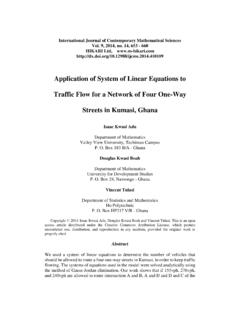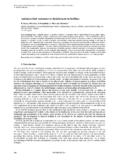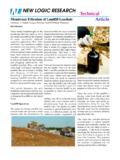Transcription of Physicochemical Characterization of SEPS Block Copolymer ...
1 Contemporary Engineering Sciences, Vol. 11, 2018, no. 1, 33 - 41 HIKARI Ltd, Physicochemical Characterization of SEPS Block Copolymer Membranes for CO2 Separation Acevedo Morantes Mar a, Tapia Alejandra and Realpe Jim nez lvaro Department of Chemical Engineering, Research Group of Modeling of Particles and Processes, University of Cartagena, Av. Consulado, Cartagena - Colombia Copyright 2018 Acevedo Morantes Mar a et al. This article is distributed under the Creative Commons Attribution License, which permits unrestricted use, distribution, and reproduction in any medium, provided the original work is properly cited. Abstract The sulfonation and incorporation of diethanolamine (DEA) in Styrene-ethylene-propylene-styrene (SEPS) Block Copolymer membranes affected the porosity and water uptake of polymer matrix.
2 Changes in hydrophilicity of polymer were identified through contact angle that is related with the influence on the transportation of gases trough the membrane . The SEPS-membranes were characterized by Fourier Transform Infrared Spectroscopy (FTIR) to elucidate the effects of modifications on the chemical structure. The membranes that were sulfonated for three hours without a carrier (3S 0C) possessed the lower angle contact, higher hydrophilicity, that was related with increase in the permeability and selectivity in other studies. Keyword- CO2 separation membranes, sulfonation, diethanolamine, carrier molecule, contact angle 1 Introduction Although the market of membranes is only 2% of application in new natural gas separation equipment [1], the scientific community has developed appreciable advances on membranes design and development, which shows a substantial potential as an alternative in separation technology due to a simple design, module equipment, small footprint and maintenance [2].
3 Other gases which could being in the feed, for instance nitrogen (N2), do not interact with diethanolamine (DEA), and their transports through the membrane occurs only by the physical mechanism of diffusion [3]. The permeability of gases, 34 Acevedo Morantes Mar a et al. influenced by a carrier, does not increase when the feed pressure reaches high values, according to the carrier saturation phenomenon [4, 5]. As a result, it is possible to reduce the energy consumption when operating at lower pressures, compared to the solution-dilution model.
4 Considering the fact that CO2 is a polarizable molecule, it is possible to improve their solubility within the membrane , while introducing some functional groups in the polymer matrix [6]. Considering the fact that CO2 is a polarizable molecule, it is possible to improve their solubility within the membrane , while introducing some functional groups in the polymer matrix [6]. The most influential parameters in the performance of a polymeric gas separation membrane , alongside the concentration and the chemical nature of the carrier, are the operating pressure and temperature [3, 5]. High temperature and harsh chemicals in the feed can damage the membrane [4].
5 Likewise, rubbery materials can provide a good resistance to plasticization effects and they are less susceptible to contaminants [7]. The relation between the contact angles with the solution of gases was analyzed to establish the influence on the transportation of gases through the membrane (permeability). The incorporation of amine carrier and sulfonic groups was evidenced by FTIR spectroscopy. 2 Materials and Methods membrane synthesis The materials and modifications of SEPS Copolymer were described by Acevedo Morantes et al. [8]. membrane Characterization 1) FTIR: It was used to identify changes in the chemical structure of membranes due to the sulfonating process and the presence of the amine carrier.
6 FTIR spectra were taken over the wavenumbers ranging from 400 to 4000 cm-1, using 128 scan and 4 cm-1 resolution. 2) Water contact angle: it was determined by drop shape analysis to establish the superficial properties of the membranes. For this purpose, a drop of distilled water was deposited on the sample placed in a horizontal position, in which the balance between solid, liquid and gas phases exists; therefore, the contact angle was measured between the tangent line in the liquid-gas contour of the drop and the liquid-gas-solid interface [9]. The previously method was replicated three times and the data of angle contact was obtained by calculate the average for each case.
7 3 Results and discussion FTIR The modifications, due to the presence of sulfonic groups and the addition of DEA as a carrier on the SEPS Copolymer , were identified. In figures 1, 2 and 3, the Physicochemical Characterization of SEPS Block Copolymer membranes 35 FTIR spectra of nonsulfonated, sulfonated, and sulfonated membranes with or without the carrier, are respectively compared. Several peaks around 3000 cm-1 and absorption bands at 1450, 1370, and 730 cm-1 related to -CH2- and -CH3 groups, were presented invariably in all spectra, which indicated that those groups were not altered in the membranes.
8 As can be seen in figure 1, nonsulfonated membranes showed a group of characteristic and defined "five aromatic fingers" bands due to the vibration model of the aromatic ring in the styrene Block between 1950 cm-1 and 1650 cm-1 [10, 11], alongside two peaks at 748 and 694 cm-1. The secondary amines such as DEA, usually present a peak between 3300 and 3500 cm-1 attributed to N-H stretching; however, it tends to be weak and difficult to be detected, likewise, C-N stretching band between 1020 and 1340 cm-1 [12]. As a result, considerable alterations in the nonsulfonated membranes with 15 and 20% of DEA was not identified, in comparison with the pure SEPS membrane (0S 0C).
9 Figure 1. FTIR spectra of non-sulfonated membranes with 0%, 15% and 20% (0S 0C, 0S 15C and 0S 20C) of DEA. Sulfonated membranes (Fig. 2) showed changes in the shape and intensity of "five aromatic fingers" bands and it is identified merely one peak at 836 cm-1, caused by a substitution in the para-position of the phenyl group during the sulfonating process. The absorption bands at approximately 1005 and 1127 cm-1 are assigned to the vibrations of sulfonic acid (-SO3H) in the para-position [10, 11, 13-16]. The peaks centered on 1200 and 1040 cm-1 can be ascribed to the asymmetric [10, 11, 17] and symmetric stretching [13, 14] vibrations of sulfonate group (O-S-O), respectively.
10 The broad absorption band at 3400 cm-1 in sulfonated membranes suggests the presence of hydroxyl groups due to the interactions between -SO3H and water molecules through hydrogen bonding [17]. All sulfonated membranes containing the carrier (Fig. 3) showed the broad absorption band at 3400cm-1 due to the hydrogen bonding with water and the variation of the "five aromatic fingers" bands by the substitution in the para-position; however the peaks related to the presence of amines groups were not 4006008001000120014001600180020002200240 026002800300032003400360038004000 Wavenumber (cm-1)0S 20C0S 15C0S 0C36 Acevedo Morantes Mar a et al.










